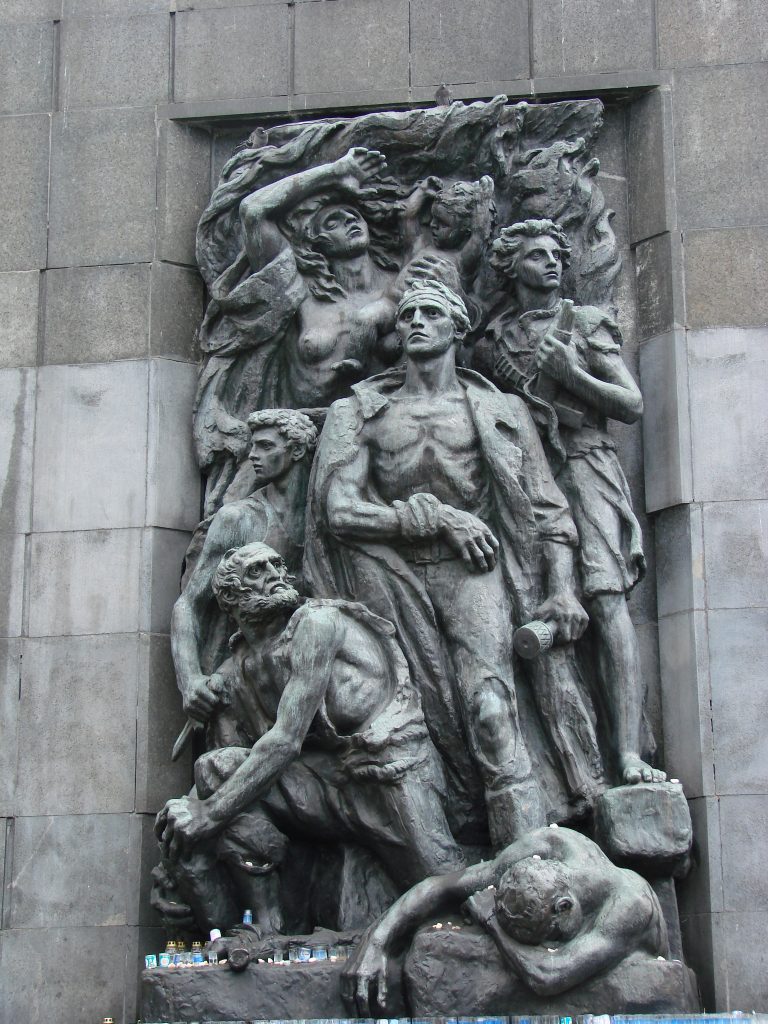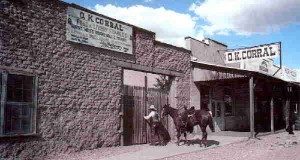“By the 1950s, the English term Holocaust came to be employed as the term for the murder of the Jews in Europe by the Nazis. Although the term is sometimes used with reference to the murder of other groups by the Nazis, strictly speaking, those groups do not belong under the heading of the Holocaust, nor are they included in the generally accepted statistic of six million victims of the Holocaust.”1 Six million is the number associated with Adolf Hitler’s murder of Jews who died during the Holocaust. The Holocaust is that episode in human history that leaves people with many questions. One of those questions is about why the Jews didn’t fight back?

Beside the fact that Jews had no access to arms and were surrounded by anti-Semitic groups, many Jews were simply unaware of what was going on. They were told that they were being relocated to a new home “in the east” and had no reason to worry.2 Another contributing factor as to why many were afraid to fight back was the German policy of collective reprisal, where helping a person of Jewish faith or origin was punishable by death, and not just for the ones helping, but also for their families.3 Entire communities were held collectively responsible, which stopped others from even trying to fight back.
The Nazis set up special “ghettos” as a part of Hitler’s plan for ridding Europe of Jews. The Nazis established these ghettos under German control to confine Jews to one concentrated area segregated from the rest of the population until those Jews could be sent either to their death or to forced labor camps. The Warsaw Ghetto, located in Warsaw, Poland, was at first enclosed with barbed wire, only to be replaced with a brick wall 10 feet high and 11 miles around. Five-hundred-thousand Jews in the surrounding areas were herded into the 840 acre ghetto until the summer of 1942. Many Jews living there had no housing at all, and the lucky few who did were typically crowded into dwellings with an average of nine people per room. Because of these unlivable and inhumane conditions, thousands died each month due to starvation and diseases such as typhus.4
When the Germans issued the order for the extermination of the Warsaw ghetto, the Jewish residents suddenly realized the gravity and inevitable reality of their deaths. From July to September of 1942, the Germans began the massive deportation and murder of the Jews in Warsaw, with transfer numbers being about 5,000 sent to the nearby death camps per day. SS and police units deported around 265,000 Jews to the Treblinka killing center. Another 11,000 were sent to forced-labor camps. Another 10,000 were murdered, and only 35,000 were granted permission to remain in the ghetto.5 For the remaining Jews in the ghetto, deportation seemed inevitable.
When reports of these mass killings at Treblinka reached Warsaw, and in response to these deportations, several underground Jewish organizations set up an armed self-defense unit. “We saw ourselves as a Jewish underground whose fate was a tragic one, the first to fight. For our hour had come without any sign of hope or rescue,” said one ZOB leader.6 The ZOB, or the Zydowska Organizacja Bojowa, was composed of roughly two-hundred members known as the Jewish Combat Organization. Another Jewish resistance group was the Jewish Military Union, or the Zydowski Zwiazek Wojoskowy (ZZW), which was formed by the Revisionist Party. At first, there was tension between these two groups, but in attempts to strengthen themselves by numbers, they decided to work together against the Germans attempting to destroy the ghetto.7
In October of 1942, the Germans issued the final liquidation of the ghettos, and a deportation of another 8,000 able-bodied residents to forced labor camps. Because of this, in January of 1943, German SS and police units tried to resume these mass deportations from Warsaw. A group of these ZOB Jewish fighters, armed with pistols, and making use of the hiding places they had created since April, infiltrated a column of Jews that were being sent to the transfer point. Given the prearranged signal, they broke ranks and fought the Germans who were escorting them. Many of these Jewish fighters died in this battle, but not in vain. The attack was just enough to disorient the Germans, which allowed for the Jews who remained in columns to disperse and make a run for it. After having seized between 5,000 and 6,000 of the ghetto residents on January 21st, 1943, the Germans suspended their deportations until April 19th, in honor of Hitler’s birthday on April 20th, and the eve of Jewish Passover.8
With the apparent success of this resistance that seemingly halted deportations, the members of the ghetto population were only encouraged to prepare for an uprising. The Jews in the ghetto believed that what had happened in January only proved that resisting was the key. They saw resisting the Germans as a possibility to end their heinous acts and defer the Germans from continuing the rest of their plans. Many began to believe that the Germans were only going to continue so long as they remained passive, and that to fight back was their only chance. After the last battle in January, those living in the Warsaw ghetto began to construct underground bunkers and shelters to prepare for an attempted final deportation by the Germans. They spent weeks training, making and acquiring arms, and making their plans to defend the ghetto. Nine months later, on April 19, 1943, the day intended for final liquidation, they mounted the Warsaw Ghetto Uprising.9 SS and police units entering the ghetto that morning saw a nearly deserted ghetto. Nearly all of the residents had gone into their hiding places or to underground bunkers.

Jewish fighters, led by 23 year old Mordecai Anielewicz, and armed with pistols, many handmade grenades, and a few automatic weapons and rifles that had been smuggled into the ghetto, surprised the Germans and their auxiliaries. The Germans were caught so off guard that they had to retreat to outside the ghetto walls. On this first day alone, German commander SS General Jürgen Stroop reported losing twelve men, killed and wounded.10

“The entire sky of Warsaw was red. Completely red.”11 In an attempt to force the remaining Jews out of hiding, on the third day of the uprising German General Stroop began to completely destroy the ghetto to the ground. Jewish resistance fighters continued to fight back by making sporadic raids from their bunkers, but the German numbers were many, and they reduced the ghetto to rubble.
On May 8, young Jewish commander Mordecai Anielewicz, along with those with him, were killed by the German forces in an attack against the ZOB command bunker. However, because of this uprising led by Anielewicz, and the organized military resistance, many other individual and small groups were inspired to hide, many in the sewers, or fight the Germans for nearly another month.

As if the entire destruction of the Warsaw Ghetto was not enough to commemorate the German victory, Stroop ordered the destruction of the Great Synagogue, one of the greatest buildings in Poland and the largest synagogue in the world at the time. Stroop then wrote his report, “The Warsaw Ghetto Is No More,” and reported having captured 56,065 Jews, and destroying 631 bunkers. He estimated that he and his units killed up to 7,000 Jews during the Warsaw uprising, and deporting about another 7,000 to the Treblinka killing center, where many died instantly by gas chamber.12 Casualty numbers on the German side are uncertain, but it is likely that they lost several hundred soldiers during the 28 days it took them to kill and deport over 400,000 Jews.
Even after the tragic ending of the Warsaw Ghetto Uprising, many individual Jews remained hiding in the ruins, and continued to attack the German patrols and their auxiliaries. The Warsaw Ghetto Uprising was the first, largest, and symbolically most important Jewish uprising. Because of this, they inspired other uprisings in the ghettos. The significance of this uprising goes beyond the fight. Anielewicz wrote, “My life’s dream has now been realized: Jewish self-defense in the ghetto is now an accomplished fact.…I have been witness to the magnificent, heroic struggle of the Jewish fighters.”13
- Encyclopedia of the Ghettos, 1990, s.v. “The World Holocaust Remembrance Center Museum” by Yad Vashem. ↵
- Encyclopedia Britannica, December 2016, s.v. “Nazi Anti-Semitism and the Origins of the Holocaust,” by Michael Berenbaum. ↵
- Christopher R. Browning, Nazi Policy, Jewish Workers, German Killers (Cambride, UK: Cambridge University Press, 2000), 22. ↵
- Encyclopedia Britannica, June 2015, s.v. “Warsaw Ghetto Uprising,” by Michael Berenbaum. ↵
- United States Holocaust Memorial Museum Encyclopedia, s.v. “Warsaw Ghetto Uprising,” by United States Holocaust Museum. ↵
- Encyclopedia Britannica, June 2015, s.v. “Warsaw Ghetto Uprising,” by Michael Berenbaum. ↵
- United States Holocaust Memorial Museum Encyclopedia, s.v. “Warsaw Ghetto Uprising,” by United States Holocaust Museum. ↵
- Encyclopedia Britannica, June 2015, s.v. “Warsaw Ghetto Uprising,” by Michael Berenbaum. ↵
- Encyclopedia Britannica, June 2015, s.v. “Warsaw Ghetto Uprising,” by Michael Berenbaum. ↵
- United States Holocaust Memorial Museum Encyclopedia, s.v. “Warsaw Ghetto Uprising,” by United States Holocaust Museum. ↵
- United States Holocaust Memorial Museum Encyclopedia, s.v. “Warsaw Ghetto Uprising,” by United States Holocaust Museum. ↵
- Encyclopedia Britannica, June 2015, s.v. “Warsaw Ghetto Uprising,” by Michael Berenbaum. ↵
- Encyclopedia Britannica, June 2015, s.v. “Warsaw Ghetto Uprising,” by Michael Berenbaum. ↵



37 comments
Josemaria Soriano
This article is of the utmost importance because, unfortunately, racist and fascist ideologies of the past are becoming so present in our actuality. The German plan for the extermination of the Jewish population was very simple: first, to establish ghettos, to watch the Jews and then to send them to the concentration camps. During World War II, one of the most important ghettos was the Warsaw Ghetto in Poland. However, there was something that impelled the Jews, and that really is the dynamite of every resistance, rebellion and revolution. I am referring to the press, to the literature, capable of encourage even the most indifferent soul. The parties and movements of the ghetto published clandestine newspapers. This press countered the German campaigns to create confusion among the Jews of the ghetto. They raised the minds of its readers and stimulated them to resist and face the enemy, something that finally happened. I would like to conclude with a reflection: if the press succeeded in awakening the Jewish people who had no hope, it is also capable of awakening our present society from existing injustices. I say this because today we pay more attention to irrelevant shows, like the Kardashians, instead of raising awareness on society about corruption or abuse of power. Now that we have the opportunity to write articles, we have to learn from the Jewish press in Warsaw, and use our power to denounce every unmoral action, in order to propel the change to prosperity.
Matthew Rios
I think it’s a shame most Jews did not fight back. Even in the most awful of circumstances, we are still left with a choice. A choice to be masters or slaves of our fate. Life sometimes seems as though it is without choices, but that is far from the truth. I don’t say this to mitigate the severity of Nazi Germany’s crimes, or the Jews’ sorrow. But it saddens me to see how we author our feelings of history in such a way that allows man to accept that some people simply did nothing to revolt. When we should all know that doing nothing in the face of injustice, should make you complicit.
Richard Navarro
It’s crazy how many Jews did not fight back or riot. I don’t think that they could ever do that in America. I don’t believe that they would be very successful. I wonder how life was living as a Jew back in those days. Especially for Jews who were not in the country and experiencing their people go through such tribulation.
Belene Cuellar
I’m really impressed with the way the author formatted this article, the amount of detail and organized structure really made the article flow. I have always been fascinated with the Holocaust and the many lives it affected. I’ve heard of Jewish resistance before, but I have never heard of the Warsaw Ghetto Uprising. I’m glad to hear that the Jews stood up against the oppression even if it meant the end of their lives.
Teresa Valdez
Considering that I did not know much about the Warsaw ghetto in the first place, this article was very informational. However, there seemed to be a little too much focus on the background information that distracted from the narrative of the uprising. It was nice that this article highlighted the resistance that the Jews put up to defend themselves from the Nazis. It is not often that the Holocaust is represented as more than the labor and death camps. This goes to show that there are so many more stories that prove the courage of the Jewish people. Great article!
Samman Tyata
Wow! I found this article well structured and very informative. Well, I had no any idea about the Warsaw Ghetto Uprising before reading this article. It’s really interesting to know that the Jews made bunkers and hiding places to fight for their own survival. You effectively explained about the people not understanding about their current situation and it’s really sad to read that the Nazis had moved 5000 Jewish people every day to the death camps. To sum it up, I found your article to be really good.
Gabriela Serrato
I am in disbelief after reading this article. I cannot believe there is not more conversation or education on this uprising. I was completely unaware actually. I cannot imagine being in the position of the millions of people imprisoned, and I find it incredibly courageous and miraculous that these people chose to fight back. I am proud that they attempted this fight although they sadly could not overcome the mass number of germans. This moment is still one of the most grim in history, and it is stories like this that will continue to prove that we should always continue to discuss history and all that it provides.
Justin Garcia
This is a great article. It is not only fluent but is also very informative. The Holocast is one of the darkest parts of human history and many only know of the tragic numbers of those who lost their lives. This article points out information that is not well known, that the Jews did fight back. This gives us new perspective that the Jews will was not broken in this time of crisis. It gives many people inspiration that against cruel rulers or groups even though it may be hard, standing up for yourself and others is important.
Alexis Renteria
Until reading this article, i was not aware of the Warsaw Ghetto Uprising or that there was an uprising at all. In my history class i only recall learning that Jews lived in fear, scared of being captured and sent to concentration camps to be killed. However, this article gives the reader another point of view on the Holocaust. Apart from all the death, fear, and sorrow, there was bravery and courage. And this article does a great job of telling that part of the story, no matter how hopeless it seemed and how many more Nazis there were, they did not give in and sacrificed themselves for the freedom of their companions.
Lisa Varela
In my high school world history class I studied the atrocities that occurred during World War ll, however, I had not learned about the Warsaw Ghetto uprising. Everytime I read about what happened during World War ll I am left speechless. But the acts of bravery that occurred in the Warsaw Ghetto is truly inspiring. This article was well written and gave great insight in the events that occurred.